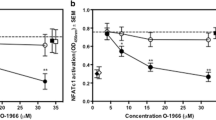Abstract
The problem of new psychoactive substances (NPS) is emerging globally. However, the immunotoxicity of synthetic cannabinoids is not evaluated extensively yet. The purpose of the present study was to investigate whether synthetic cannabinoids (JWH-210 and JWH-030) induce adverse effects on lymphoid organs, viability of splenocytes and thymocytes, and immune cell activator and cytokines in mice. JWH-210 (10 mg/kg, 3 days, i.p.) is more likely to have cytotoxicity and reduce lymphoid organ weight than JWH-030 of ICR mice in vivo. We also demonstrated that JWH-210 administration resulted in the decrease of expression levels of T-cell activator including Cd3e, Cd3g, Cd74p31, and Cd74p41, while JWH-030 increased Cd3g levels. In addition, JWH-210 reduced expression levels of cytokines, such as interleukin-3, interleukin-5, and interleukin-6. Furthermore, we demonstrated that a CB2 receptor antagonist, AM630 inhibited JWH-210-induced cytotoxicity, whereas a CB1 receptor antagonist, rimonabant did not in primary cultured splenocytes. These results suggest that JWH-210 has a cytotoxicity via CB2 receptor action and results in decrement of lymphoid organ weights, T-cell activator, and cytokine mRNA expression levels.







Similar content being viewed by others
References
Brazin KN, Mallis RJ, Li C, Keskin DB, Arthanari H, Gao Y, Wu SL, Karger BL, Wagner G, Reinherz EL (2014) Constitutively oxidized CXXC motifs within the CD3 heterodimeric ectodomains of the T cell receptor complex enforce the conformation of juxtaposed segments. J Biol Chem 289:18880–18892
Cha HJ, Lee KW, Song MJ, Hyeon YJ, Hwang JY, Jang CG, Ahn JI, Jeon SH, Kim HU, Kim YH, Seong WK, Kang H, Yoo HS, Jeong HS (2014) Dependence potential of the synthetic cannabinoids JWH-073, JWH-081, and JWH-210: in vivo and in vitro approaches. Biomol Ther (Seoul) 22:363–369
Fattore L, Fratta W (2011) Beyond THC: the new generation of cannabinoid designer drugs. Front Behav Neurosci 5:60
Friedman H, Newton C, Klein TW (2003) Microbial infections, immunomodulation, and drugs of abuse. Clin Microbiol Rev 16:209–219
Gagnon E, Schubert DA, Gordo S, Chu HH, Wucherpfennig KW (2012) Local changes in lipid environment of TCR microclusters regulate membrane binding by the CD3epsilon cytoplasmic domain. J Exp Med 209:2423–2439
Griffin G, Atkinson PJ, Showalter VM, Martin BR, Abood ME (1998) Evaluation of cannabinoid receptor agonists and antagonists using the guanosine-5′-O-(3-[35S]thio)-triphosphate binding assay in rat cerebellar membranes. J Pharmacol Exp Ther 285:553–560
Hermanns-Clausen M, Kneisel S, Szabo B, Auwarter V (2013) Acute toxicity due to the confirmed consumption of synthetic cannabinoids: clinical and laboratory findings. Addiction 108:534–544
Hohmann N, Mikus G, Czock D (2014) Effects and risks associated with novel psychoactive substances: mislabeling and sale as bath salts, spice, and research chemicals. Dtsch Arztebl Int 111:139–147
Huffman JW, Szklennik PV, Almond A, Bushell K, Selley DE, He H, Cassidy MP, Wiley JL, Martin BR (2005) 1-Pentyl-3-phenylacetylindoles, a new class of cannabimimetic indoles. Bioorg Med Chem Lett 15:4110–4113
Institute of Laboratory Animal Resources (U.S.) (1996) Guide for the care and use of laboratory animals. National Academy Press, Washington, D.C., pp xii–125
Karinen R, Tuv SS, Oiestad EL, Vindenes V (2015) Concentrations of APINACA, 5F-APINACA, UR-144 and its degradant product in blood samples from six impaired drivers compared to previous reported concentrations of other synthetic cannabinoids. Forensic Sci Int 246:98–103
McKallip RJ, Lombard C, Fisher M, Martin BR, Ryu S, Grant S, Nagarkatti PS, Nagarkatti M (2002a) Targeting CB2 cannabinoid receptors as a novel therapy to treat malignant lymphoblastic disease. Blood 100:627–634
McKallip RJ, Lombard C, Martin BR, Nagarkatti M, Nagarkatti PS (2002b) Delta(9)-tetrahydrocannabinol-induced apoptosis in the thymus and spleen as a mechanism of immunosuppression in vitro and in vivo. J Pharmacol Exp Ther 302:451–465
Mocellin S, Provenzano M, Rossi CR, Pilati P, Nitti D, Lise M (2003) Use of quantitative real-time PCR to determine immune cell density and cytokine gene profile in the tumor microenvironment. J Immunol Methods 280:1–11
Rieder SA, Chauhan A, Singh U, Nagarkatti M, Nagarkatti P (2010) Cannabinoid-induced apoptosis in immune cells as a pathway to immunosuppression. Immunobiology 215:598–605
Robinson RH, Meissler JJ, Breslow-Deckman JM, Gaughan J, Adler MW, Eisenstein TK (2013) Cannabinoids inhibit T-cells via cannabinoid receptor 2 in an in vitro assay for graft rejection, the mixed lymphocyte reaction. J Neuroimmune Pharmacol 8:1239–1250
Robinson RH, Meissler JJ, Fan X, Yu D, Adler MW, Eisenstein TK (2015) A CB2-selective cannabinoid suppresses T-cell activities and increases Tregs and IL-10. J Neuroimmune Pharmacol 10:318–332
Seely KA, Prather PL, James LP, Moran JH (2011) Marijuana-based drugs: innovative therapeutics or designer drugs of abuse? Mol Interv 11:36–51
Showalter VM, Compton DR, Martin BR, Abood ME (1996) Evaluation of binding in a transfected cell line expressing a peripheral cannabinoid receptor (CB2): identification of cannabinoid receptor subtype selective ligands. J Pharmacol Exp Ther 278:989–999
Starlets D, Gore Y, Binsky I, Haran M, Harpaz N, Shvidel L, Becker-Herman S, Berrebi A, Shachar I (2006) Cell-surface CD74 initiates a signaling cascade leading to cell proliferation and survival. Blood 107:4807–4816
Tanaka Y, Koido S, Xia J, Ohana M, Liu C, Cote GM, Sawyer DB, Calderwood S, Gong J (2004) Development of antigen-specific CD8+ CTL in MHC class I-deficient mice through CD4 to CD8 conversion. J Immunol 172:7848–7858
Vremec D, Pooley J, Hochrein H, Wu L, Shortman K (2000) CD4 and CD8 expression by dendritic cell subtypes in mouse thymus and spleen. J Immunol 164:2978–2986
Yao B, Mackie K (2009) Endocannabinoid receptor pharmacology. Curr Top Behav Neurosci 1:37–63
Acknowledgments
This study was funded by the Ministry of Food and Drug Safety, Republic of Korea (grant number 15181MFDS482).
Author information
Authors and Affiliations
Corresponding authors
Ethics declarations
Ethical approval
All experimental procedures were approved by the Animal Ethics Committee, National Institute of Food and Drug Safety Evaluation and complied with the Guide for the Care and Use of Laboratory Animals (National Research Council (NRC) 1996).
Conflict of interest
The authors declare that they have no conflicts of interest.
Electronic supplementary material
Rights and permissions
About this article
Cite this article
Gu, S.M., Lee, H.J., Lee, Th. et al. A synthetic cannabinoid JWH-210 reduces lymphoid organ weights and T-cell activator levels in mice via CB2 receptors. Naunyn-Schmiedeberg's Arch Pharmacol 390, 1201–1209 (2017). https://doi.org/10.1007/s00210-017-1418-8
Received:
Accepted:
Published:
Issue Date:
DOI: https://doi.org/10.1007/s00210-017-1418-8




